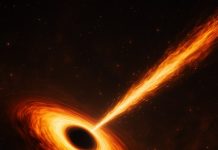
Black holes are among the most fascinating things in the universe. They are strange, thrilling, and can’t be avoided.
We can notice the sound they make, like a bird’s chirp, when two of them join together. Up until now, about 70 of these sounds have been picked up.
A group of scientists at the Heidelberg Institute for Theoretical Studies (HITS) now thinks that these chirps usually happen in two specific frequency ranges among the chorus of these cosmic sounds.
They shared their findings in The Astrophysical Journal Letters.
The Groundbreaking Findings of Gravitational Waves
The detection of gravitational waves, predicted by Albert Einstein a century ago, was confirmed in 2015. This breakthrough earned the scientists a Nobel Prize in Physics two years later.
The real fun started with the birth of gravitational-wave astronomy. When two black holes merge, they send out waves that increase in frequency, resulting in the chirp signal that we can pick up on Earth.
By studying the changes in this signal, scientists can understand the ‘chirp mass,’ which combines the masses of the two merging black holes.
People have generally thought that black holes merging could be of any size. But the team at HITS suggests that some black holes are of standard sizes which produce these universal chirps.
The Implications of Universal Chirp Masses
Understanding these chirps helps us learn how black holes form and which stars will explode in a supernova, says Fabian Schneider, the leader of the study at HITS.
Additionally, this information gives us more insight into how supernovae work, helps us understand uncertain nuclear and star physics, and gives scientists a new method to measure the universe’s speeded-up expansion.
Predicting the Final Destinies of Stars
Stars that are 3 to 100 times bigger than our Sun end up collapsing into black holes instead of exploding in supernovae.
These black holes are created from stars born in binary star systems, which have gone through several episodes of mass exchange. Both black holes come from stars that have been stripped of their outer layers.
This process of stripping affects the final outcomes of the stars. It increases the chance of stars exploding in a supernova and leads to the creation of universal black hole masses, according to the simulations by the team.
Spotting Universal Chirps
With the improvement in gravitational-wave detectors, we are finding more remnants of stars.
There appears to be a gap in the chirp masses of merging black holes and hints of peaks at around eight and 14 times the size of our Sun. These findings match the universal chirps predicted by the HITS team.
“Any patterns we see in black-hole and chirp masses can teach us a lot about how these things formed,” says Eva Laplace, another author of the study.
Discovering Larger Black Holes Beyond Our Galaxy
Since the first detection of merging black holes, it’s clear that there are black holes much larger than those in our galaxy. These big black holes come from stars with different chemical compositions than in our Milky Way.
The HITS team shows that these stars, when stripped of their outer layers in close binaries, create black holes less than nine and more than 16 times the size of our Sun, but hardly any in between.
In merging black holes, the universal black-hole masses of roughly nine and 16 times the Sun’s size naturally lead to universal chirp masses, that is, universal sounds.
Future of Gravitational-Wave Observations
While updating his lecture on gravitational-wave astronomy, Schneider noticed that the gravitational-wave observatories had detected a lack of chirp masses and an excess at the exact universal masses predicted by their models.
He says that since the number of observed black-hole mergers is still quite small, it’s not yet clear if this data is just a statistical anomaly or not.
Regardless of what future gravitational-wave observations may reveal, the findings will certainly be thrilling.
They will help scientists gain a better understanding of where these cosmic singers, the black holes, come from in this cosmic sea of sounds.
The study was published in The Astrophysical Journal Letters.
Follow us on Twitter for more articles about this topic.
Copyright © 2023 Knowridge Science Report. All rights reserved.



